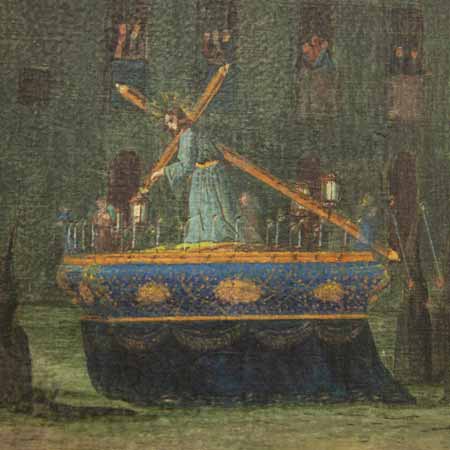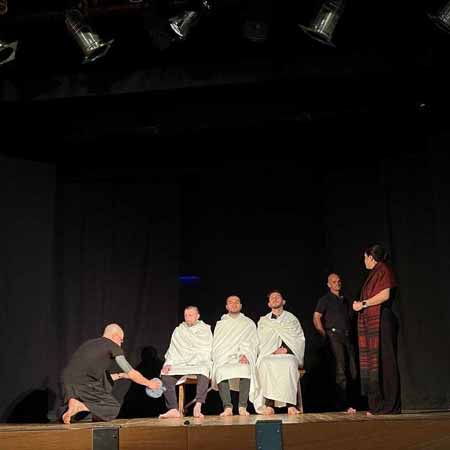This World is a Bridge
Last week, twenty six BePeriod students gathered in Northern Italy to study Esoteric Christianity. Traces of this ancient teaching can still be found in the mosaic decorations of the churches of Ravenna. But these mosaics were never meant to be studied academically…
How can you teach someone who is not unified, who one moment is one person and the next moment shifts into being an entirely different one?
This question is of particular relevance to our teaching because its premise is that we are made of three distinctly different parts: a Physical Body with an instinctive/motor function, an Essence with an emotional function, and a Personality with a mental function (described in more detail here). Speak only to our bodies, you leave our hearts and minds ignorant. Speak only to our hearts, you leave our bodies and our minds ignorant. Speak only to our minds, you leave our bodies and our hearts ignorant. Such one-sided instruction informs only a third of our being and leaves two-thirds in the dark. The enlightened minority remains under the sway of the ignorant majority, who continues dictating our actions in spite of what has been learned.
We took this into consideration last week, when twenty six BePeriod students gathered in Northern Italy to study Esoteric Christianity. Traces of this ancient teaching can still be found in the mosaic decorations of the churches of Ravenna, many of which date to the 5th and 6th centuries CE. These mosaics, which are some of the earliest existing Christian art, were never meant to be studied academically. They were made to convey a practical teaching and were designed to be experienced with a person’s entire being. Christian practitioners achieved this through performing the Biblical stories they studied in what came to be known as Mystery Plays.
Reenactment of Christ’s Passion
The early Christians were not alone in using theater to experience their teaching. Theater has its roots in Ancient Greece, quite possibly even earlier. It is suspected (but not yet archaeologically confirmed) that the Egyptians enacted their myths in public. The Ancient Babylonians are also thought to have done the same. Be that as it may, in the early Christian world, stories from the Old and New Testaments were performed by amateur actors for their local audiences. This was not for entertainment alone; the effort of performance involves all the functions—the instinctive/moving, emotional, and intellectual. In effect, the lesson behind the performance permeates one’s entirety, rather than being restricted to just a third of one’s being.
Taking our cue from this, and drawing inspiration from one of the more striking mosaics in the Basilica of Sant’Apollinare Nuovo, we staged the story of Abraham and Sarah. This Biblical couple were challenged by God to leave their homeland and travel to Canaan. An underlying theme of their story is sacrifice and payment, a subject well known to any practitioner of inner farming, for inner farming always requires that we sacrifice something dear to our imaginary picture of ourselves. What is real can only grow at the expense of the artificial.
One currency of payment indispensable to inner farming is patience. Nothing of value comes quickly. It takes time to learn the basic ideas of this teaching, and much more time to observe their manifestation in ourselves. It takes time to build our experience, to commit a large enough portion of ourselves to this work so that we can then make consistent and serious efforts. New practitioners learn this the hard way, always having to sacrifice the disappointment of not advancing as quickly as they had initially hoped. With time, we learn to value making effort without expecting an immediate reward; making effort for effort’s sake.
This fundamental understanding is embodied in the story of Abraham and Sarah. Despite God’s promise that their seed will one day populate the land of Canaan, when the play commences, this prospect seems hopelessly out of reach. Sarah is barren, unable to have a child. Canaan is plagued by drought. On the verge of giving up, the couple are visited by God in the form of a Trinity of Archangels. Abraham and Sarah recognize the identity of their mysterious visitors, welcome them generously, and beg them to explain what has been delaying the fulfillment of God’s promise. “Why leave our homeland? Why settle here?” pleads Sarah.
Abraham, Sarah, and the Three Guests
“Your past is no longer and your future is yet to unfold,” responds the Archangel. “You must sacrifice the one to earn the other. This world is a bridge, Abram and Sarai, that must be crossed over without lingering.”
BePeriod Students Performing the Play of Abram and Sarai
In scripting the Archangels to say this in our play, we are weaving in a saying from an entirely different school of thought. The quotation is attributed to Abu Bakr, the first Caliph after Muhammad and the alleged founder of Sufism. “This world is a bridge,” said Abu Bakr. “Cross by it and do not linger on it.” But the sentiment was not exclusive to the founder of Sufism. Nachman of Breslov, the 18th-century founder of the Breslov Hasidic movement famously said: “The whole entire world is a very narrow bridge, and the main thing is not to be overcome by fear.” The world is a bridge and life is a journey at the end of which we leave the Physical Body and Personality behind.
Yet according to another premise of this teaching, Essence predates our birth, and in a way incomprehensible to our logical mind, continues hereafter. Whatever we fix into our Essence during the journey of life, we take to the beyond. This is the entire point of inner farming, and it can only be achieved at the price of sacrifice.
No one can make this payment for us. Only we ourselves can pay. But it helps a great deal to travel the bridge of life alongside other practitioners.




